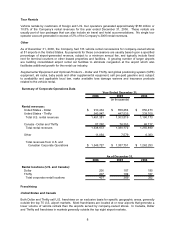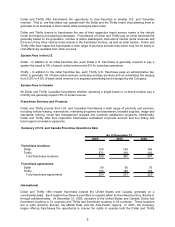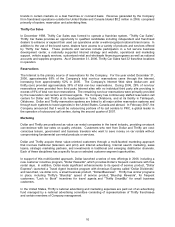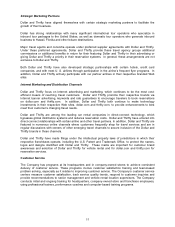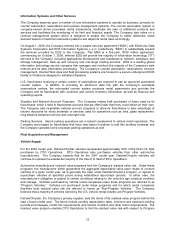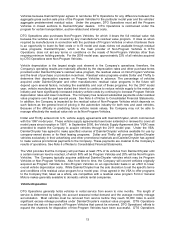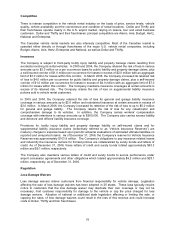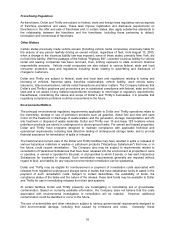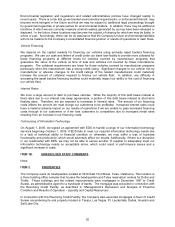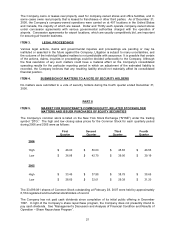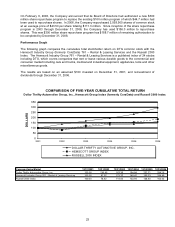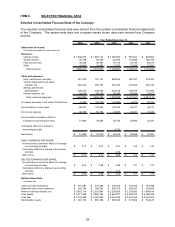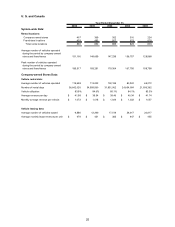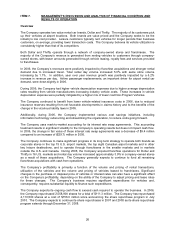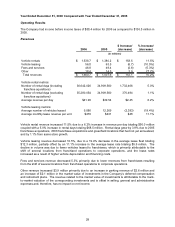Thrifty Car Rental 2006 Annual Report Download - page 24
Download and view the complete annual report
Please find page 24 of the 2006 Thrifty Car Rental annual report below. You can navigate through the pages in the report by either clicking on the pages listed below, or by using the keyword search tool below to find specific information within the annual report.the airline industry and airline restructuring through bankruptcy may cause airlines to reduce flight
schedules which could adversely impact the number of airline passengers. A significant reduction in
airline passengers or any event that significantly disrupts air travel could negatively impact our results.
Concentration in Leisure Destinations
We have a significant presence in key leisure destinations and earn a large portion of our revenue from
these markets. Rental revenue from Florida, Hawaii, California and Nevada represented approximately
60% of our total rental revenue in 2006. Reductions in leisure travel to these destinations resulting from
natural disasters, terrorist acts, general economic conditions or other factors would have a material
impact on our results.
Vehicle Supply and Residual Values
Our vehicle supply agreement with DaimlerChrysler extends through model year 2011 and we generally
purchase 80% to 90% of our vehicles from DaimlerChrysler. Under the vehicle supply agreement, we
must purchase 75% of our vehicles from DaimlerChrysler up to certain targeted volumes and
DaimlerChrysler has agreed to provide us certain minimum volumes of vehicles. The vehicle supply
agreement also requires that 80% of the vehicles at the initial targeted volumes be vehicles covered by a
manufacturer program that guarantees the value of the vehicle at the time of sale. Residual value
programs such as the vehicle supply agreement enable us to determine depreciation expense, which is
our largest single cost element, on Program Vehicles in advance.
Our yearly vehicle requirements usually exceed the amounts that DaimlerChrysler has agreed to provide
under the vehicle supply agreement. Historically, DaimlerChrysler has agreed to sell us more vehicles
than we must buy under the vehicle supply agreement. We have also acquired vehicles from other
manufacturers to meet our vehicle requirements. For the 2006 model year, DaimlerChrysler vehicles
represented approximately 93% of the Company’s U.S. fleet. We depend on DaimlerChrysler to continue
to provide vehicles above the amounts included in the vehicle supply agreement. Alternatively, we have
the ability to purchase vehicles from other manufacturers to satisfy our ongoing vehicle requirements.
Each year, we negotiate these purchase agreements that are outside the vehicle supply agreement.
Vehicle manufacturers, including DaimlerChrysler, have recently stated their intent to reduce vehicle
supply to the rental car industry and have significantly increased industry vehicle costs by increasing
Program Vehicle depreciation rates and lowering incentives. The inability of any of the major vehicle
manufacturers to sell enough vehicles to the industry could adversely affect our results. Furthermore, if
the vehicle manufacturers change the size or terms of their residual value programs, we could experience
increased residual value risk or increased depreciation rates on Program Vehicles that could be material
to our results of operations and could adversely affect our ability to finance our vehicles.
Additionally, if DaimlerChrysler defaults on the vehicle supply agreement for any reason, we could be left
with a material unpaid balance from DaimlerChrysler with respect to Program Vehicles that were sold for
an amount less than the guaranteed residual value or for incentive and reimbursement payments that
were not paid.
Market Risk in Vehicle Disposition
We have generally retained the used car market value risk on 15% to 35% of our vehicles and plan to
increase this percentage in 2007 and future periods. The depreciation costs for these vehicles are highly
dependent on the strength of used car prices at the time of sale. A large unexpected decline in used car
prices would have a significant adverse impact on our results.
Customer Surcharges
In almost every state, we recover various costs associated with the title and registration of our vehicles
and, where permitted, the concession cost imposed by airport authorities or the owners and/or operators
of the premises from which our vehicles are rented. Consistent with industry-wide business practices, we
separately state these additional surcharges in our rental agreements and invoices and disclose the
existence of these surcharges to customers together with an estimated total price, inclusive of these
surcharges, in all distribution channels. This standard practice complies with the Federal Trade
18


